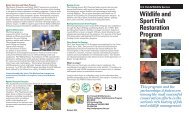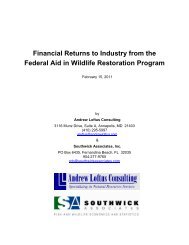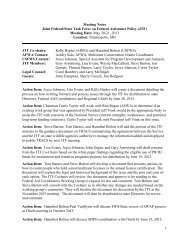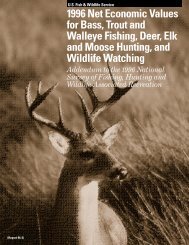Program Update - Wildlife and Sport Fish Restoration Program - U.S. ...
Program Update - Wildlife and Sport Fish Restoration Program - U.S. ...
Program Update - Wildlife and Sport Fish Restoration Program - U.S. ...
You also want an ePaper? Increase the reach of your titles
YUMPU automatically turns print PDFs into web optimized ePapers that Google loves.
<strong>Sport</strong> <strong>Fish</strong><br />
<strong>Restoration</strong><br />
Michigan Sturgeon Research<br />
Since 2001, the Michigan Department of Natural Resources <strong>and</strong> Michigan State<br />
University have used Dingell Johnson <strong>Sport</strong> <strong>Fish</strong> <strong>Restoration</strong> Act funds for<br />
collaborative lake sturgeon research in Black Lake <strong>and</strong> the upper Black River.<br />
Research has focused on current population status, recruitment dynamics <strong>and</strong><br />
bottlenecks to recruitment, <strong>and</strong> the evaluation of various supplementation strategies.<br />
One of the unique aspects of the research program was the construction <strong>and</strong> use of<br />
a streamside rearing facility. This allowed researchers to conduct research on lake<br />
sturgeon in their natal waters.<br />
Aquatic Resources<br />
Education<br />
Results of the research program at Black Lake have already been used to design<br />
restoration efforts in other waters around the Great Lakes. In addition, the results<br />
have documented that lake sturgeon natural recruitment in Black Lake continues<br />
to be very low <strong>and</strong> as a result the Michigan DNR, Michigan State University, <strong>and</strong><br />
Tower Kleber Inc. (owner of the hydropower dams on the upper Black River) are<br />
constructing a permanent streamside rearing facility that will be used to supplement<br />
natural recruitment in the upper Black River to insure the continued health of this<br />
lake sturgeon population.<br />
Aquatic Resources Education at the Indiana State Fair<br />
Aquatic resources education, including an introduction to the sport of fishing, is an<br />
important component of the Indiana DNR Division of <strong>Fish</strong> <strong>and</strong> <strong>Wildlife</strong> use of Dingell<br />
Johnson <strong>Sport</strong> <strong>Fish</strong> <strong>Restoration</strong> Act funds.<br />
The DNR building on the Indiana State Fairgrounds has a rich education history.<br />
Since the 1920’s, the DNR has used this building to educate <strong>and</strong> inform state residents<br />
of the value <strong>and</strong> utility of natural resources. Most of the approximately 700,000 annual<br />
fairgoers visit the DNR building.<br />
In 2006, Indiana’s aquatic education effort was exp<strong>and</strong>ed by the addition of a fishing<br />
pond at the DNR’s State Fairgrounds building for use during the fair <strong>and</strong> at other<br />
selected times. The goals of the project are to teach children to fish at the fair <strong>and</strong> to<br />
expose the adults that accompany them to the fun associated with teaching children to<br />
fish.<br />
The fishing pond was part of a larger DNR State Fair building renovation. A $600,000<br />
<strong>Sport</strong> <strong>Fish</strong> <strong>Restoration</strong> grant provided funds for the fishing pond, interactive<br />
educational components <strong>and</strong> modification of old aquariums into a living stream<br />
educational display. Mentors, usually volunteers from local fishing clubs, have proven<br />
to be an abundant resource for helping the kids to fish, making this program cost<br />
efficient <strong>and</strong> effective.<br />
The program has multiple benefits. Many children get to catch their first fish, <strong>and</strong><br />
hopefully get hooked on fishing in the process. The adults that accompany the children<br />
learn how easy it is to expose children to a lifelong sport <strong>and</strong> a good way to spend<br />
time outdoors. Countless fairgoers are treated to the opportunity to watch exited kids<br />
catching their first fish, an experience intended to encourage them to give fishing a try.<br />
28 <strong>Wildlife</strong> <strong>and</strong> <strong>Sport</strong> <strong>Fish</strong> <strong>Program</strong> <strong>Update</strong> September 2008










